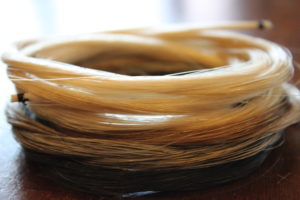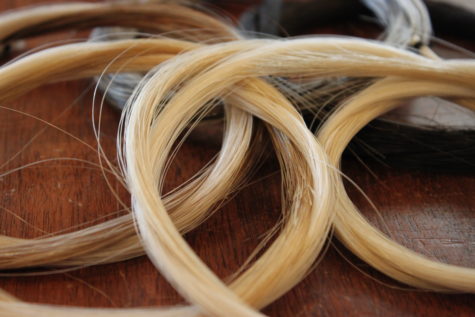When rehairing a bow we offer six standard varieties of horse hair, each with a different shade and texture. We only use natural horse hair that is never bleached or treated with harsh chemicals. It is hand sorted for texture, thickness and length. Since color and texture is correlated, the smoother hairs are white and coarse hairs are dark.
Traditional White
As the name implies, traditional white hair is the most commonly used texture. Most bow makers use this type of hair on their bows and we use it when no special hair type is requested. The hair is sorted by hand in two stages to ensure each hair is a consistent diameter with even, relatively smooth texture throughout the hair. This hair is often referred to as Mongolian or Siberian hair.
Platinum White
Platinum white hair is the finest of all the hair we use. It is sorted three times to ensure only the smoothest and most elastic hairs are present. More bouncy than traditional hair, it allows for quick spiccato strokes and a clean, pure tone. For some, the smoothness will feel like there is not enough traction. This hair is best for airy baroque pieces or compositions by Mozart however it tends to make romantic pieces more challenging. This hair is often marketed as “Stallion” hair.
Golden White
Golden White hair is what we prefer to use on cello bows and is also popular with folk players who need a more durable white hair. It is slightly thicker than traditional white hair with more texture. The extra coarseness helps engage thick cello strings more quickly while still producing a clean sound. The thicker diameter also makes the hairs more durable and less prone to breaking under pressure. It is by far our most popular hair for cellists. While it is increasing in popularity for some violinists and violists, the extra texture can result in extraneous surface noise. There is no common term for this hair because most shops do not offer this texture.
Grey Hair
Grey Hair is not really grey, but more like a mixture of white and brown with the color drifting towards the end. This texture of hair is not well known to exist but it is squarely between Salt & Pepper hair and Golden White hair. It is most commonly used by musicians who have to play outside in very humid settings or who employ a bowing technique known as Chopping. The hair is thicker than Golden White and more consistent in diameter than Salt & Pepper hair. There is no common term for this hair because most shops do not offer this texture.
Salt & Pepper Hair
As it sounds, Salt & Pepper hair is a mixture of black and white hair. The goal is to temper the coarseness of the black hairs with the smoother white hairs. The diameter of each hair is thicker than average and less elastic. The hairs are also more wavy and less uniform. The overall result of this mixture is coarse but not as coarse as pure black hair. The combination of thick black hair and thinner white hair makes it somewhat inconsistent for classical violin, viola and cello bows but it is very popular for bass bows.
Black Hair
Black hair is the most coarse of all the bow hair and has the largest diameter. It is mostly used for bass bows. The extra friction from the coarse hair helps grab the thick bass strings more easily than other types of hair. It is occasionally used on violin, viola and cello bows when grip is more important than tonal clarity. It produces a lot of surface noise, or “hissing” when played on a violin, viola or cello.

Six types of hair stacked in order of texture.


